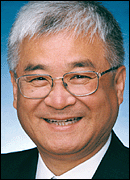

![]()
Pacific Perspective


![]()
Pacific Perspective
Who is the ultimate loser
in the Hynix fiasco?Hynix Semiconductor Inc. of Korea (formerly known as Hyundai Electronics Industrial Co.) is the world's third largest memory chipmaker. Its pre-tax operating losses in the second and third quarters of this year amounted to $2.32 billion.
This dismal performance follows a net loss of $1.92 billion on total sales of $6.5 billion last year and it is sitting on a pile of debt amounting to a mind-boggling $6.65 billion (as reported in early October). It may go bankrupt unless something happens to alter the excess supply of memory chips.
The most recent share price was $1.35, a decline of more than 90 percent from the highest price recorded in 1999. Four major bailout programs have been implemented for Hynix's survival since the beginning of this year. In January, Korean banks that had large exposure to Hynix's debt agreed to purchase $2.23 billion of Hynix's maturing bonds, followed by a $4.4 billion rescue package in May.
Salomon Smith Barney raised $1.25 billion in June by issuing global depository receipts (GDRs) Investors who purchased the GDRs witnessed their investments evaporating into thin air as the Hynix share price collapsed. In early November, the Korea Exchange Bank initiated another multibillion dollar rescue package, including a debt-to-equity swap of up to $3.3 billion of Hynix's debt and a liquidity loan of $500 million.
This series of bailout programs infuriated Hynix's competitors such as the U.S. Micron Technology and Germany's Infineon.
Although the Korean government denies its direct involvement in these bailout programs, most of the banks with large exposure to Hynix's debts are either government-controlled or nationalized banks.
What is effectively happening is the nationalization of Hynix using public funds. The combined exposure to Hynix's debt of government-controlled or nationalized banks amounts to almost $4 billion, and these banks have to write off 50 percent to 75 percent of their loans to Hynix. And who is paying the price? The Korean taxpayers and individual investors holding Hynix shares.
The Korean government has injected more than $115 billion of public funds or one-quarter of GDP to recapitalize and restructure the banking sector since the Asian financial crisis. Korean taxpayers are paying this amount and will continue to pay in the foreseeable future. Hynix's debt only adds more to their tax payment.
Why can't the Korean government stop supporting an ailing company like Hynix? Simply put, the Hynix fiasco started when it was forced to acquire its Korean competitor, LG Semiconductor Co. Ltd., along with its debt of $4.5 billion, as part of the corporate sector reform programs dictated by President Kim Dae Jung's administration. It was one of many fanfare cases of corporate restructuring in Korea. Unfortunately, the government-led reform programs usually lack sound economic and financial justification. It is not surprising that the Korean government is reluctant to admit its mistakes through the demise of Hynix.
S. Ghon Rhee is the K.J. Luke Distinguished Professor of International Finance and Banking at the University of Hawaii at Manoa. Reach him at rheesg@hawaii.edu.